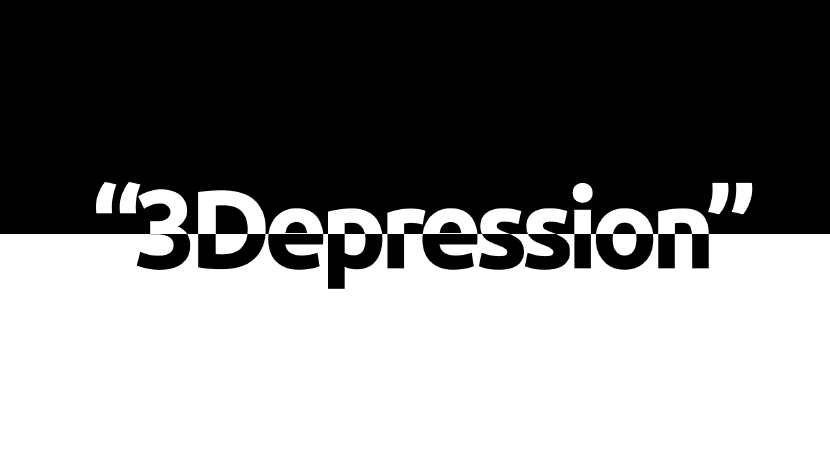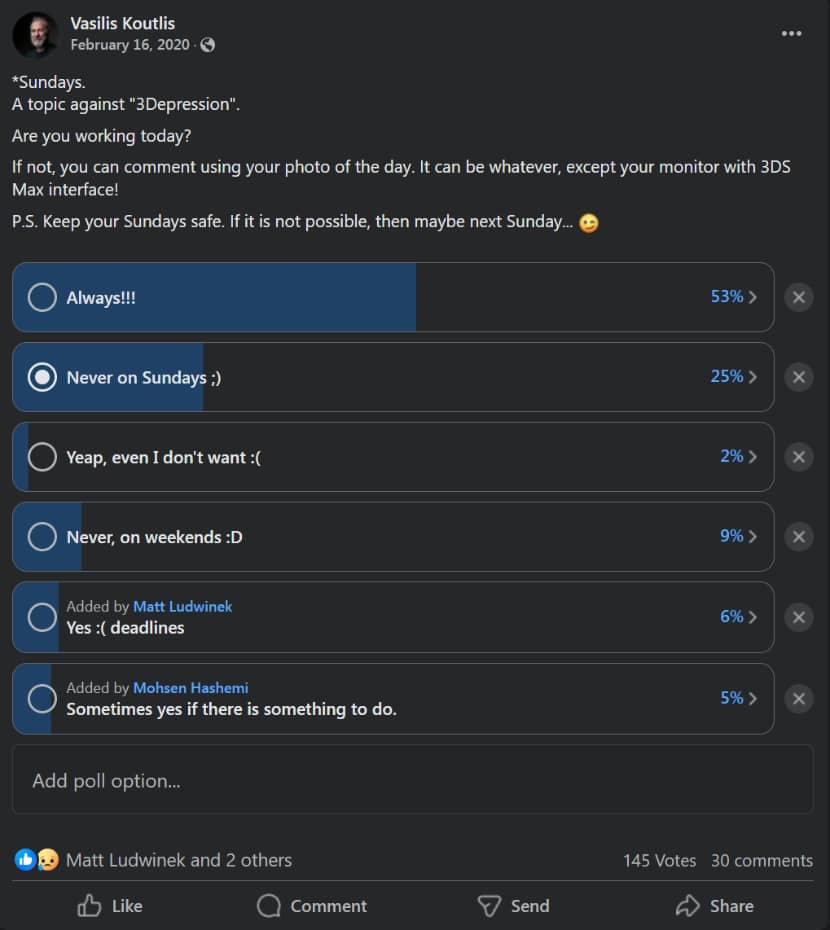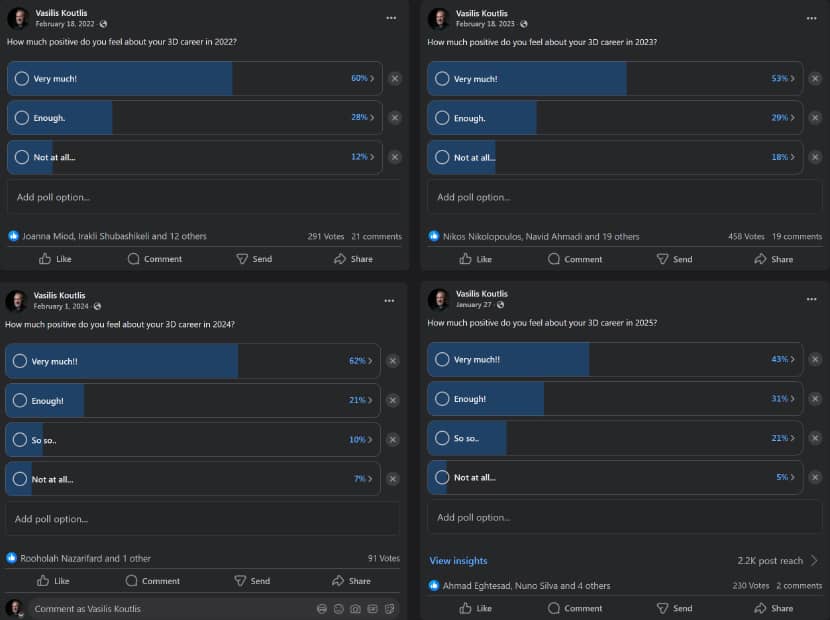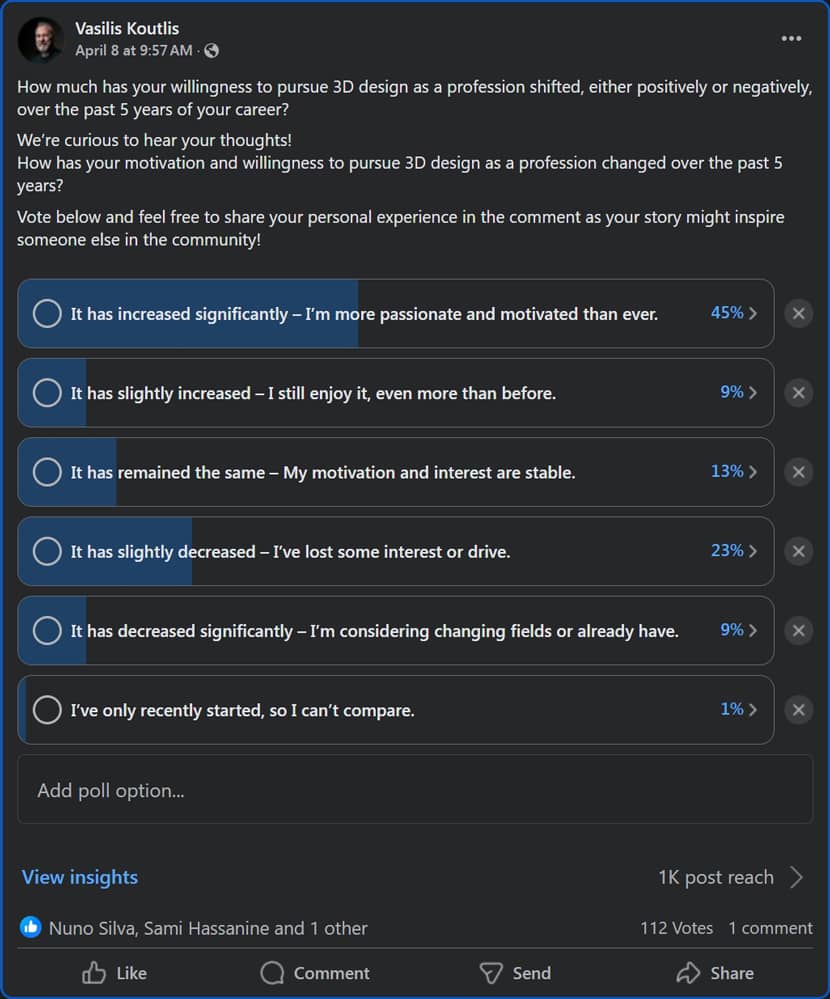
It was January 30th, 2020—5 a.m. Despite having promised myself never to work around the clock again, I found myself overwhelmed with emotion. The private confessions of fellow 3D artists kept echoing in my mind—their struggles, their instability, their exhaustion. I, too, was not okay at that moment. So instead of continuing my nocturnal workflow, I stopped. I started writing. Thoughts, realizations, and insights began to pour out, all centered on how we can learn to 'invert our normals.' The post was ready. All that remained was to click 'post.' I hesitated. Should I share something so raw and vulnerable? I thought about it again and again. Let it be.
"3Depression" is a simple yet resonant term that was born from that post and soon became a cornerstone topic within the VWArtclub community. The story I shared wasn’t just mine; it was ours. And once it was out there, the response was overwhelming. Dozens of artists spoke from the heart in this post but also to me privately, revealing a shared truth: "Many of us, beneath the polished renders and pixel-perfect compositions, are silently suffering."
3Depression: When the Render Queue Meets Reality.
A few months before my post, an artist confided in me: "I feel horrible, and I fight with extreme depression. I removed all my projects from everywhere because I think I'm not such a good artist."
Another revealed his medical diagnosis: "I visited a specialized doctor and realized I had panic attacks for years. I didn’t even know what they were."
A third message resonated deeply: "Many people in 3D talked to me about their mental condition. I tried to support them. But I only truly understood their struggle once I experienced it myself."
Their words echoed something fundamental: "We are unique—sensitive, fragile, perfectionists who chase beauty in a world that isn't always kind. We must fight to preserve our thin skin."
And so I shared my own story: "About a year ago, I faced a strong depression. I managed to overcome it in my own way. It’s absolutely normal. Most 3D artists don’t live a normal life, as we are artists and that means we’re emotional beings."
The Polls That Speak Volumes.
Through the years, VWArtclub has conducted several polls that offer valuable insight into the psychological patterns of 3D artists. Let’s examine a few of them.

The question was quite simple: “Are you working today? (Sunday Poll, 2020)” and out of 145 respondents:
- 53% admitted they always work on Sundays
- Only 25% said they never work on Sundays
This means that nearly 3 out of 4 3D artists often work on weekends, a statistic that supports one of the central concerns from our original post and that's the lack of rest and recovery.
We also tracked how artists felt about their 3D career outlook across four last years:

- 2022: 60% "Very much!" positive
- 2023: 53%
- 2024: 62%
- 2025: 43%
While there was a rise in optimism in 2024, it dropped significantly in 2025, indicating that external or industry-wide shifts may affect morale. After Covid and the regional wars of recent years, we could not claim that we live on a planet with stability that gives us optimism. Additionally, AI probably offers a feeling of uncertainty.
Finally, a very recent poll with the topic: "How has your motivation changed over the past 5 years?" (April 2025)

- 45% said it has increased significantly
- 9% said it has slightly increased
- 13% claimed it has remained the same
- 23% admitted it has slightly decreased
- 9% said it has decreased significantly
Nearly one-third of artists confessed to a decrease in motivation, while around half felt more passionate than ever. This duality reveals how fragile and unpredictable our creative energy can be.
Voices from the Community.
These poll numbers would mean little without the stories behind them. Here are just a few comments that added heart and depth to the discussion:
Karolina Makowska: "So many comments, and so many thoughts. The distance between us is big, we are representing different countries, different ways of living, but we all faced the 'black background' at least once. The truth is that we are living in the blue light of our monitors, looking for perfection, understanding and beauty, alone. It's easy to forget how important the balance is when it's 5 in the morning and you are still testing the lightning, comparing your work to the reference image. You feel so exhausted, your body is losing energy, but the brain is still going on 100%, along with the CPU. A river of ideas, tick-tock, another tea, tick-tock, more tests, tick-tock, comparing your work, tick-tock, heavy head, sleepy eyes, just one more render tick-tock, omg, this fu*king region to repair.. tick-tock, done, done, done. This circle repeated constantly is making you sick, you need fuel, your body needs fuel. Not a Corona Sun, not Vray Sun, planes and portals won't help you either. No matter how great you are at dealing with the digital suns, don't forget about the real one. Try to go out, travel, drink wine on the beach with friends, and dance. The mechanism of healing is amazing. Don't lose your hopes, talk about your problems, save your thin skin. We are not machines, we rule them, and when we are strong, our thoughts are clear, our concepts and images are greater.
- Optimize your work
- Save time for pleasures
- Organize your day (I'm using the toggle app for this)
- Analize your habits
- Talk about your problems, but not just to complain, ask for advice - look for the solution
It's going to be fine, you are going to be fine!"
Markus Baader: "The problem these days is that we’re constantly surrounded by perfect snapshots—beautiful people, happy people, stunning artwork. Everything shared online tends to be the polished, curated version of reality. The same goes for artwork: what you see on social media is just the best part of the process, never the struggles behind it.
With all the platforms out there, you're bombarded by artists from every corner of the world. I don’t know how many 3D artists exist globally—let’s just assume it’s around a million. Now, imagine just 1% of them are better than you. That’s 10,000 artists. If only 10% of them post on social media, that’s 1,000. And if each of those posts has just 5 images a year, you end up seeing 5,000 amazing artworks—possibly in a single day.
And here’s the catch: those 5,000 images are from the top 1%. No wonder it starts to feel like everyone’s better than you, while you're the only one struggling. Social media, combined with sheer numbers, can easily mess with your perception—making you feel like you're the only one who sucks while everyone else is thriving. Just my two cents."
Hassan Jaber: "I believe there are many reasons behind the negative feelings we often experience in our industry, and I’ll try to sum them up in a few key points:
- Clients often don’t understand the time and effort it takes to create a high-quality render. That’s why they tend to reach out at the very last minute, expecting fast turnarounds and tight deadlines. We're often forced to work day and night to meet those demands—or risk losing the job.
Solution: Always communicate your workflow clearly from the beginning. If the client insists on a rushed deadline, ask for a higher fee. If they’re willing to pay more, that means they value your time and effort. If they don’t (and most won’t), then perhaps they’re not the kind of client you want to work with in the first place. - Some clients expect a $5,000 job for $200, claiming they know someone who can do it for less.
Solution: These are usually the same clients who will message and email you around the clock, acting like they own your time. Don’t fall into this trap. You’re under no obligation to work with people who don’t respect your values. Just walk away—and don’t feel guilty about it. - The market is full of talented artists, and competition is fierce. The pressure to compete with the best can be overwhelming and often leads to stress and burnout.
Solution: Unlike the previous situations, this kind of stress—stress-the one that pushes you to grow and level up—is actually valuable. The fear of falling behind can be a powerful motivator. Embrace it. Use it to keep moving forward and evolving. Growth takes time, but it pays off."
Mannat Taneja: "In India, mental health isn’t taken seriously. I was stressed, my health deteriorated, and only then did I seek help. Work is just one part of life."
Stefanie Chapman: "Imposter syndrome is real. Social media can make it worse. Balance is key."
Javier Salcedo: "I’ve had panic attacks, anxiety. Now I take guitar lessons, sleep more, and get professional help. We stare too long at screens, imagining polygons. We need to return to the real world."
Leo de Brito: "When I work too long from home, I feel strange and anxious. The days I meditate and work out—those are the best days."
Ahmed M. Gbr: "Long hours in front of the screen brought me severe anxiety. Even stages I loved—like lighting—began to trigger stress. I smoke too much. I barely move. I wish for a normal life, even if it sounds funny."
Robert Dukes: "It’s a constant battle to get better. I used to burn out. Now I set boundaries, tell clients to wait, and I feel so much better."
Data-Driven Reality.
From earlier polls hosted on VWArtclub, we gathered these statistics:
| Poll Question | Yes (%) | No (%) |
|---|---|---|
| Do you often work on weekends? | 87% | 13% |
| Have you experienced burnout due to 3D work? | 76% | 24% |
| Do you feel imposter syndrome? | 68% | 32% |
| Do you work more than 8 hours/day? | 82% | 18% |
| Have you ever felt isolated due to remote work? | 64% | 36% |
These numbers reinforce what the stories reveal: mental fatigue, isolation, and identity crises are common in the 3D art world.
"Invert Your Normals": A Metaphor for Healing.
In 3D modeling, flipping normals corrects visual artifacts by reorienting surfaces to face the right direction. It’s an apt metaphor for the psychological work artists must do: we must reorient ourselves, flip our mental surfaces, and rebuild clarity.
We don’t need a one-size-fits-all solution. As I said in 2020, "3D artists are brilliant people, and they can find their own way to get rid of their 'black background'."
But here are a few ideas drawn from our collective wisdom:
- Set boundaries: Stop working on Sundays, even if it feels unnatural at first.
- Seek professional help: Therapy and counseling can make a difference.
- Share your journey: Talking about struggles is the first step toward healing.
- Exercise and unplug: A short walk or a social activity can recharge your brain.
- Redefine perfection: 75% is often more than enough.
A Final Word.
The evolving psychology of 3D artists is complex, as there is a tension between passion and pressure, creativity and commerce. What we need is honesty, connection, and courage. As artists, we have the power to visualize the impossible. Let’s turn that power inward. Let’s visualize better lives for ourselves.
I really hope you found this article interesting and positive, providing valuable insights to stay informed and keep up your 3D career the right way and mainly the most optimistic one.
Kind regards & Keep rendering! 🧡

About the author
Vasilis Koutlis, the founder of VWArtclub, was born in Athens in 1979. After studying furniture design and decoration, he started dedicating himself to 3D art in 2002. In 2012, the idea of VWArtclub was born: an active 3D community that has grown over the last 12 years into one of the largest online 3D communities worldwide, with over 160 thousand members. He acquired partners worldwide, and various collaborators trusted him with their ideas as he rewarded them with his consistent state-of-the-art services. Not a moment goes by without him thinking of a beautiful image; thus, he is never concerned with time but only with the design's quality.
